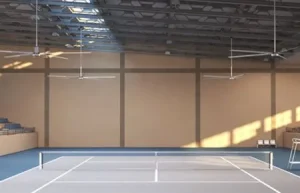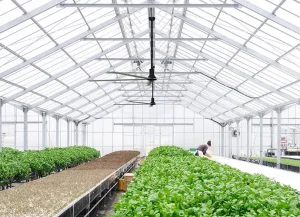Do you often struggle with poor air circulation and uneven temperatures in large spaces? Many businesses find themselves facing high energy costs while trying to cool large industrial and commercial spaces. The solution is simple: HVLS fans. These powerful fans provide high-volume air movement at low speeds, making them ideal for large facilities and warehouses.
HVLS fans are designed to circulate large volumes of air in industrial spaces, improving air circulation, temperature control, and energy efficiency. They are commonly used in warehouses, factories, sports centers, and commercial buildings, offering significant benefits in both comfort and cost savings.

Application of HVLS Fans in tennis court
HVLS stands for high volume, Low Speed, and these fans are specifically designed to move a large volume of air at a low speed. Unlike traditional ceiling fans, which focus on smaller areas and higher speeds, HVLS fans are engineered to create a cooling effect over vast spaces, improving air circulation and creating a comfortable environment in places like warehouses, factories, and gyms.
Because of their ability to circulate air effectively, they can help reduce cooling costs by distributing cool air evenly throughout large spaces, improving air quality and creating a more productive environment. These fans are perfect for large commercial and industrial settings, where temperature control is crucial to the comfort and productivity of employees.
HVLS fans are incredibly versatile, making them ideal for a variety of large spaces. They are commonly found in the following environments:
The benefits of HVLS fans are numerous, particularly in environments like warehouses, factories, and large commercial spaces. Here’s why they are so effective:
In addition to their cooling effects, HVLS fans also have a positive impact on air quality. By constantly circulating air, they help prevent the build-up of stale air and improve ventilation in large spaces. This is particularly important in environments such as factories or warehouses, where contaminants, odors, and excess moisture can accumulate. Here’s how HVLS fans contribute to better indoor air quality:
While both HVLS fans and traditional ceiling fans serve to circulate air, there are some key differences that make HVLS fans more suitable for industrial and commercial spaces:
The industrial fan design offers several advantages:
| Feature | HVLS Fan | Traditional Fan |
|---|---|---|
| Coverage Area | 2,000-30,000 sq ft | 100-400 sq ft |
| Energy Usage | Low | High per sq ft |
| Maintenance | Annual | Quarterly |
| Air Movement | Even Distribution | Spotty Coverage |
Choosing the right HVLS fan for your industrial or commercial space depends on several factors, including the size of the room, airflow requirements, and the specific cooling needs of your environment. Here are some factors to consider:
One of the main selling points of HVLS fans is their ability to enhance energy efficiency. When used in conjunction with air conditioning systems, HVLS fans can improve air circulation, making the cooling process more efficient. By circulating the air effectively, these fans reduce the load on HVAC systems, leading to:
HVLS fans are highly beneficial in agricultural settings such as barns, poultry farms, and greenhouses. They help maintain optimal temperature and humidity levels, which is critical for both animal welfare and crop growth. Here’s how they contribute to agricultural applications:

HVLS Fans in Agricultural Applications
HVLS fans are ideal for large commercial and industrial environments, where maintaining a consistent air temperature and quality is crucial for productivity and comfort. Common applications include:
The initial investment in HVLS fans may be higher than traditional fans, but the long-term savings make them a cost-effective solution for large spaces. By reducing energy consumption and improving airflow, these fans offer significant ROI in the form of:
What is the difference between HVLS fans and regular ceiling fans?
HVLS fans are designed to move larger volumes of air at lower speeds, making them ideal for large commercial and industrial spaces. Ceiling fans, on the other hand, are smaller and typically designed for residential use.
Can HVLS fans reduce energy costs?
Yes, HVLS fans improve air circulation and reduce the strain on HVAC systems, leading to significant energy savings over time.
Where are HVLS fans typically used?
HVLS fans are commonly used in warehouses, factories, gyms, commercial spaces, and agricultural settings to enhance airflow, improve comfort, and reduce energy consumption.
Are HVLS fans worth the investment?
Yes, while the initial investment may be higher, the energy savings, improved comfort, and enhanced productivity make HVLS fans a cost-effective solution in the long run.

Hi, I’m Michael Danielsson, CEO of Vindus Fans, with over 15 years of experience in the engineering and design industry. I’m here to share what I’ve learned. If you have any questions, feel free to contact me at any time. Let’s grow together!